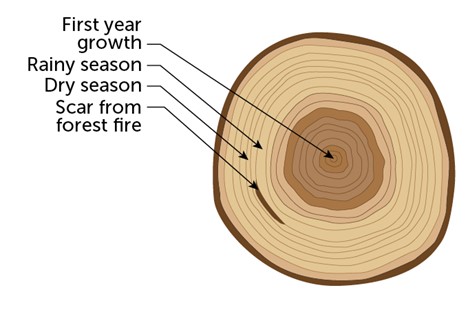We wish we could bring you along on a shrinking magic school bus to explore the intricate inner workings of trees. However, since our names aren’t Ms. Frizzle, we will do our best to describe how amazing trees are and explain why understanding the biology of trees affects the way we work on them.
Most of us have seen a cross-section of a tree or at least a picture of one. There are obvious layers and tree rings, but do you know the purpose of each layer?

Bark
The outermost layer of the tree is the bark. Bark has a specific job, which is to help protect the most important tissues of the tree, the vascular system. When the bark of the tree is disrupted or injured, oftentimes, the next few vital layers are also disrupted, which can cause major implications for the health of a tree.
As we venture inward, past the outer bark, we reach the internal bark which is the phloem layer. (Pictured below) Phloem is vital in transporting nutrients created in photosynthesis throughout the rest of the tree. It is a pipeline of cells that eventually die and become part of the bark layer.

Cambium Layer
Slightly further into the tree, we find the next layer; the cambium layer. Cambium plays a critical role in growth. This meristematic layer is comprised of dividing cells to create more bark and more wood, growing the tree’s girth annually. You can see the growth of new wood in annual growth rings in the next layer, sapwood.
The sapwood layer consists of xylem. Xylem is a system of cells that carry water and minerals up from the ground and roots. Essential water is transported through the tree and aids in the photosynthetic process that happens through the leaves.
Heartwood
Getting closer to the center of the tree, we reach the heartwood. In many species of trees, this is the darker colored wood at the center of the cross-section. Heartwood also has xylem cells that no longer conduct water and minerals, so the heartwood functions as support for the tree.
It’s important to note that because the heartwood is dead wood (with non-living cells), if a tree becomes hollow due to internal decay, it could still stand for a very long time, thriving. Remember, it is the outer layers (the phloem, cambium & xylem) that keep the tree alive.

As we mentioned already, the sapwood is comprised of tree rings, or annual growth rings. Some tree species show these rings more clearly than others, but all tree rings tell the life story of trees. Rings that are tight together can indicate years that lacked water or had other stressors that hindered growth, whereas rings that are more spread out can indicate years of abundant growth. Scars in the rings can tell of trunk wounds, forest fires, insect damage, and other events. Counting the rings will reveal the age of the tree and how long it has been standing to watch history unfold.

Girdling
Girdling is a common practice in forestry when thinning trees per a forest management plan. However, our landscape trees can greatly suffer when girdled by accident from mower or equipment damage to the trunk. If a tree becomes completely girdled (as shown in the picture below) the life-giving tissues of the tree will be cut off and the tree will die.

Knowing the science behind how trees function and thrive affects the way we work with them. Our pruning practices take into consideration the health and well-being of trees.
Climbing tools
When climbing in trees, we are mindful of these important layers by using specialized tools like ‘Cambium Savers’ that help reduce friction damage from ropes to the tree. Climbing gaffs are a great tool to help us climb trees, but because of the wounds made by these spikes, they should only be used in trees we are removing.

Trees are a vital part of our world. They are our silent partners in the community. It’s our job as arborists to understand the science behind how they work and how they interact with the environment around them. Through certifications and continuing education, we stay up to date on arboriculture research and the newest scientific findings. As we learn more about trees, we can better care for them. Give us a call if you would like an arborist to talk to you about your trees and how our services could benefit them.

